Ap biology exam 3 - Study guides, Class notes & Summaries
Looking for the best study guides, study notes and summaries about Ap biology exam 3? On this page you'll find 235 study documents about Ap biology exam 3.
Page 2 out of 235 results
Sort by
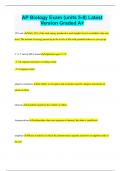
-
AP Biology Exam (units 5-8) Latest Version Graded A+
- Exam (elaborations) • 19 pages • 2024
- Available in package deal
-
- $9.99
- + learn more
AP Biology Exam (units 5-8) Latest Version Graded A+ 10% rule Only 10% of the total energy produced at each trophic level is available to the next level. The amount of energy passed up to the levels of the food pyramid reduces as you go up. 3' vs 5' end of DNA strand replication goes 3'->5' - 3' (of original molecule) is leading strand - 5' is lagging strand adaptive immunity the ability to recognize and remember specific antigens and mount an attack on them altruism ...
![AP Biology [Practice AP Exam] Questions with Verified Solutions](/docpics/5583362/666496862f937_5583362_121_171.jpeg)
-
AP Biology [Practice AP Exam] Questions with Verified Solutions
- Exam (elaborations) • 13 pages • 2024
- Available in package deal
-
- $9.99
- + learn more
AP Biology [Practice AP Exam] Questions with Verified Solutions [8] Cells that make up salivary glands would be expected to contain a relatively large amount of: ----------------------------------------------- [A] smooth endoplasmic reticulum [B] rough endoplasmic reticulum [C] genetic material [D] lipids [E] peroxisomes [B] rough endoplasmic reticulum [9] Which of the following characteristics distinguishes prokaryotic organisms from eukaryotic organisms? ----------...
![AP Biology [Practice AP Exam] Questions and Answers (Graded A)](/docpics/5221272/663a5298645c3_5221272_121_171.jpeg)
-
AP Biology [Practice AP Exam] Questions and Answers (Graded A)
- Exam (elaborations) • 26 pages • 2024
- Available in package deal
-
- $10.39
- + learn more
AP Biology [Practice AP Exam] Questions and Answers (Graded A) [C] They Include compartments where hydrogen ions are concentrated. [1] Which of the following is true of both mitochondria and chloroplasts? ----------------------------------------------- [A] They are found in the cells of eukaryotic autotrophs and heterotrophs. [B] They include stacks of membranes that absorb light. [C] They Include compartments where hydrogen ions are concentrated. [D] They produce sugars using energ...
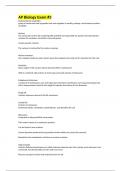
-
AP Biology Exam #3
- Exam (elaborations) • 6 pages • 2024
-
- $10.39
- + learn more
AP Biology Exam #3 Endomembrane organelles group of membranes and organelles that work together to modify, package, and transport proteins and lipids Nucleus The central part of the cell containing DNA and RNA and responsible for growth and reproduction - contains the nucleolus, chromatin, and nucleoplasm Contain genetic material The nucleus is enclosed by the nuclear envelope Nuclear envelope Has a double membrane and contains pores that regulate entry and exit of materials ...
![AP Biology [Practice AP Exam]; with Complete Solutions](/docpics/5964040/66b474ed6c123_5964040_121_171.jpeg)
-
AP Biology [Practice AP Exam]; with Complete Solutions
- Exam (elaborations) • 11 pages • 2024
- Available in package deal
-
- $10.99
- + learn more
AP Biology [Practice AP Exam]; with Complete Solutions [D] interactions between amino acids present in the polypeptide. Correct answer-[2] The tertiary structure and function of a polypeptide is principally determined by the: ----------------------------------------------- [A] length of the polypeptide. [B] number of nucleotides present in the polypeptide. [C] repeated units of glycerol making up the polypeptide. [D] interactions between amino acids present in the polypeptide. [E] numbe...
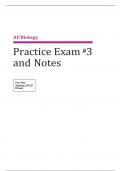
-
AP Biology Practice Exam #3 and Notes (Questions & Answers)Verified Answers)UPDATED 2024
- Exam (elaborations) • 113 pages • 2023
- Available in package deal
-
- $17.29
- + learn more
includes questions & Answers for AP Biology Practice Exam #3 and Notes(Questions & Answers)Verified Answers UPDATED 2024
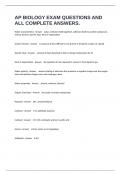
-
AP Biology Study Guide Exams All Solved Correct Package Deal Bundle(All Chapters Included) Latest 20242025 Updated.
- Package deal • 9 items • 2024
-
- $39.05
- + learn more
1 Exam (elaborations) Unit 3 AP Bio Test Questions And Already Passed Answers. 2 Exam (elaborations) BIOLOGY UNIT 7 AP LATEST EXAM QUESTIONS ALL SOLVED CORRECT. 3 Exam (elaborations) Biology Exam AP Study Guide Exam Questions And Actual Answers. 4 Exam (elaborations) BIOLOGY AP MIDTERM Questions And All Passed Answers. 5 Exam (elaborations) Bio
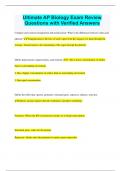
-
Ultimate AP Biology Exam Review Questions with Verified Answers
- Exam (elaborations) • 23 pages • 2024
- Available in package deal
-
- $9.99
- + learn more
Ultimate AP Biology Exam Review Questions with Verified Answers Compare and contrast transpiration and translocation. What is the difference between xylem and phloem? Tranpspiration is the loss of water vapor from the surgace of a plant through the stomata. Translocation is the channeling of the sugar through the phloem. Define hypoosmotic, hyperosmotic, and isomotic 1. Has a lower concentration of solutes than its surrounding enviorment 2. Has a higher concentration of solutes than i...
![AP Biology [Practice AP Exam] Questions and Answers (Graded A)](/docpics/5222297/663a71c87c444_5222297_121_171.jpeg)
-
AP Biology [Practice AP Exam] Questions and Answers (Graded A)
- Exam (elaborations) • 26 pages • 2024
-
- $12.49
- + learn more
AP Biology [Practice AP Exam] Questions and Answers (Graded A) [C] They Include compartments where hydrogen ions are concentrated. [1] Which of the following is true of both mitochondria and chloroplasts? ----------------------------------------------- [A] They are found in the cells of eukaryotic autotrophs and heterotrophs. [B] They include stacks of membranes that absorb light. [C] They Include compartments where hydrogen ions are concentrated. [D] They produce sugars using energ...
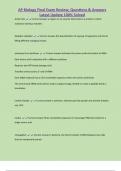
-
AP Biology Final Exam Review; Questions & Answers Latest Update 100% Solved
- Exam (elaborations) • 11 pages • 2024
- Available in package deal
-
- $11.49
- + learn more
AP Biology Final Exam Review; Questions & Answers Latest Update 100% Solved Active Site Correct answer-a region on an enzyme that binds to a protein or other substance during a reaction. Adaptive radiation Correct answer-the diversification of a group of organisms into forms filling different ecological niches. aminoacyl trna Synthase Correct answer-Activates the amino acids that attach to tRNA Each amino acid is attached with a different synthase Requires two ATP bonds (energy-rich) ...

How did he do that? By selling his study resources on Stuvia. Try it yourself! Discover all about earning on Stuvia


